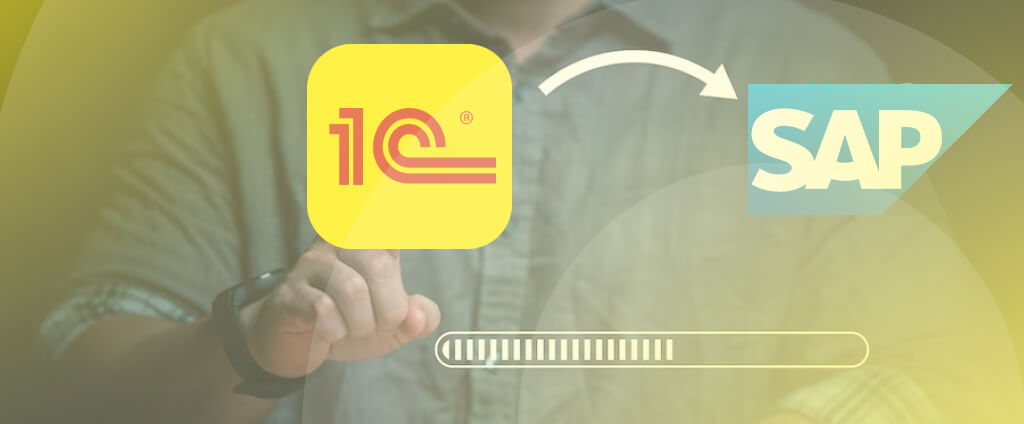With SAP exiting Russia, many businesses are now looking for local ERP alternatives. 1C offers a complete replacement, optimized for the Russian market. In this article, we’ll explore 1C’s solutions, their similarities and differences with SAP, and how to successfully transition to 1C, with real-life examples of companies who’ve made the switch.
In 2022, as international vendors like SAP withdrew from Russia, many Russian companies faced the challenge of finding a replacement for foreign ERP systems. According to TAdviser, around 50% of large Russian companies were using SAP products. However, with the halt of sales and support in 2024, staying with SAP became more difficult.
Russian businesses are now adopting local ERP solutions, with 1C being one of the most popular alternatives. These solutions offer similar functionality to SAP, addressing a wide range of business automation needs.
SAP Alternatives with 1C
1C systems can cover about 80% of the functionality that SAP provides. The remaining 20% is typically covered with additional modules and customizations.
1C solutions are widely used as SAP alternatives. Key options include:
- 1C: ERP – A leading ERP solution that aligns with international ERP standards. It covers all types of accounting, management, and reporting, along with tools for business analysis and operational activities. It integrates easily with other software and supports e-reporting and data exchange with banks and government agencies. Security is high, meeting Russian standards.
- 1C: CPM – Designed for large companies and holdings, this solution automates accounting, planning, and management. It enhances strategic decision-making by improving financial risk management, working capital, and budgeting. It also speeds up reporting and increases accuracy in managing investment projects.
- 1C: ERP for Holdings – Ideal for companies seeking a unified platform for automating various accounting types, IFRS/IAS reporting, and managing risks, finances, assets, and procurement. It streamlines interaction between the parent company and subsidiaries, providing a centralized management solution.
1C regularly updates its products to meet international standards, often working with experts experienced with SAP to make 1C’s interface and functionality more similar to SAP’s.
Comparing SAP and 1C ERP Systems
When comparing SAP S/4 HANA and 1C:ERP, both systems offer comparable development capabilities. However, SAP tends to be more complex, which makes it harder to learn and navigate. On the other hand, 1C simplifies data centralization, offering easy access to documents from various modules like Accounting, Procurement, or Inventory.
The architecture of 1C ERP allows users to access the same document from multiple modules, making data management smoother. During the transition from SAP to 1C, data migration quality is critical. A well-managed migration ensures that the system runs smoothly, while poor data handling can create confusion and reduce efficiency.
1C ERP is significantly more affordable than SAP, especially with current exchange rates and the shortage of SAP specialists. For companies sticking with SAP, maintenance costs can be high due to the need for regular updates to comply with Russian legislation.
Advantages of 1C over SAP
- 1C interface is more intuitive for local users than SAP.
- It complies with Russian laws without needing additional modifications.
- The implementation timeline is much shorter, typically a few months depending on complexity.
- Costs are 5-10 times lower than SAP.
- Finding local experts is easier, as 1C has a broader talent pool in Russia.
1C has also developed modules like 1C:Personnel, which serves as a local alternative to SAP’s SuccessFactors.
Strategies for Migrating from SAP to 1C
There are two main approaches to migrating from SAP to 1C:
- One-time migration: This involves transferring all business processes at once. It’s faster and more cost-effective but carries higher risks.
- Phased migration: This approach transfers parts of the SAP system gradually while keeping some systems active. While more time-consuming and expensive, it reduces risk.
In integration, there are two options: without a middleware (simpler but less scalable) or with a special bus (which centralizes data exchange and offers more flexibility, though it requires more resources and increases risk).
Steps for a Successful Transition from SAP to 1C
For medium and large companies, it’s essential to define the project scope upfront. You can either transition fully from SAP or implement 1C in phases. A detailed functional and non-functional requirement list should be created to align with the chosen 1C product.
The transition process typically begins with a preliminary assessment. This involves interviewing key stakeholders, analyzing current processes, and identifying critical SAP functions that must be migrated first.
The initial phase includes studying the company’s business processes, designing the new system architecture, and defining any gaps between the standard 1C solution and the company’s specific needs.
Assino client’s examples of SAP to 1C Transitions
- Yazaki Volga: Faced with the risk of losing access to SAP due to vendor exit, Yazaki Volga transitioned to 1C:ERP. The result? Faster reporting, improved cost accounting, and a 65% reduction in errors. The system also improved inventory turnover and traceability, increasing data access speed by 90%.
- Auto Parts Manufacturer: A major auto parts manufacturer switched from SAP to 1C: ERP in 8 months, successfully transferring all accounting blocks and integrating with production and quality systems. The company now handles operational and management accounting more efficiently, with improved regulatory reporting.
- Tablogix Holding: This company transitioned from SAP to 1C:CPM to comply with Russian regulations. The project was completed quickly, using standard 1C functionalities. This allowed the company to scale its operations, automate accounting, improve procurement management, and implement treasury management.
Choosing the Right Partner for the Transition
Some companies may try to handle the SAP-to-1C transition in-house to save costs, but this often leads to risks. If a team member leaves or gets diverted, the project could fall behind. Moreover, this adds extra responsibility to the IT manager, which may be overwhelming.
When choosing a contractor, consider the following:
- References: Get recommendations from reliable sources and verify them.
- Successful Cases: Look for contractors with experience in your industry and similar projects.
- Expertise: Ensure the team has qualified 1C-certified specialists.
- Reputation: Check the company’s ratings and certifications with 1C.
- Cost: While important, price shouldn’t be the only deciding factor.
- Communication: Evaluate how well the contractor understands your needs and processes.
Conclusion
Switching from SAP to 1C can be an efficient, cost-effective solution for businesses seeking an ERP system that’s better suited to local needs. By choosing the right approach, customizing the system to meet specific requirements, and working with experienced professionals, your company can ensure a smooth and successful transition.
Free expert consultation

Arthur Narimanov
Leading Consultant 1C




